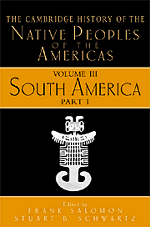Book contents
- Frontmatter
- Contents
- List of Illustrations
- Introduction
- 1 Testimonies: The Making and Reading of Native South American Historical Sources
- 2 Ethnography in South America: The First Two Hundred Years
- 3 The Earliest South American Lifeways
- 4 The Maritime, Highland, Forest Dynamic and the Origins of Complex Culture
- 5 The Evolution of Andean Diversity: Regional Formations (500 B.C.E.–C.E. 600)
- 6 Andean Urbanism and Statecraft (c.E. 550–1450)
- 7 Chiefdoms: The Prevalence and Persistence of “Señoríos Naturales” 1400 to European Conquest
- 8 Archaeology of the Caribbean Region
- 9 Prehistory of the Southern Cone
- 10 The Fourfold Domain: Inka Power and Its Social Foundations
- 11 The Crises and Transformations of Invaded Societies: The Caribbean (1492–1580)
- 12 The Crises and Transformations of Invaded Societies: Andean Area (1500–1580)
- 13 The Crises and Transformations of Invaded Societies: Coastal Brazil in the Sixteenth Century
- Index
Introduction
Published online by Cambridge University Press: 28 March 2008
- Frontmatter
- Contents
- List of Illustrations
- Introduction
- 1 Testimonies: The Making and Reading of Native South American Historical Sources
- 2 Ethnography in South America: The First Two Hundred Years
- 3 The Earliest South American Lifeways
- 4 The Maritime, Highland, Forest Dynamic and the Origins of Complex Culture
- 5 The Evolution of Andean Diversity: Regional Formations (500 B.C.E.–C.E. 600)
- 6 Andean Urbanism and Statecraft (c.E. 550–1450)
- 7 Chiefdoms: The Prevalence and Persistence of “Señoríos Naturales” 1400 to European Conquest
- 8 Archaeology of the Caribbean Region
- 9 Prehistory of the Southern Cone
- 10 The Fourfold Domain: Inka Power and Its Social Foundations
- 11 The Crises and Transformations of Invaded Societies: The Caribbean (1492–1580)
- 12 The Crises and Transformations of Invaded Societies: Andean Area (1500–1580)
- 13 The Crises and Transformations of Invaded Societies: Coastal Brazil in the Sixteenth Century
- Index
Summary
This volume, the third in the Cambridge History of the Native Peoples of the Americas, presents the history of the indigenous peoples of South America from the earliest peopling of the continent to the 1990s. It concentrates on continental South America but also makes some reference to peoples of the Caribbean and lower Central America who were linguistically or culturally connected to South America. A volume of such chronological, geographical, and ethnographic scope is a daunting challenge. It has rarely been attempted. The last great benchmark compilation on the peoples of South America, Julian Steward’s Handbook of South American Indians (1946), which was digested but also denatured in Steward and Faron’s (1959) Native Peoples of South America, influenced a generation of scholarly inquiry. As editors, we looked upon the present volume as a way of integrating much of what has been learned and altered in the half century since the publication of that work, and as a means of making these new findings and studies available to a wide readership.
The Handbook, although it contains some excellent historical research, was evolutionist rather than historical in its overarching intention. We are concerned with presenting South Americans as historical actors in the full sense.
The present volume is not a handbook or an encyclopedia but rather an idea-oriented history. It does aim at broad coverage, but it emphasizes development of general themes rather than completeness. Not every group will be mentioned, nor every society explained, but the broad patterns and general processes that large clusters of them shared will be delineated and discussed. Some authors have questioned habitual analytical blocs, some have reconceptualized periodizations, and many have problematized the common labels under which South American peoples are grouped. Among the idea-oriented approaches we encouraged were those that sought to relate indigenous peoples’ own reported or selfdocumented ideas about the past with the record as constructed through exterior views. This volume marks an early stage in the encounter between “histories of Indians” and “Indian histories,” which are gradually taking shape as native peoples overcome their longstanding marginalization from the orbit of Spanish/Portuguese literacy and win the standing of conceptual protagonists.
It may be useful for readers to know the process by which this book came into being.
- Type
- Chapter
- Information
- Publisher: Cambridge University PressPrint publication year: 1999



